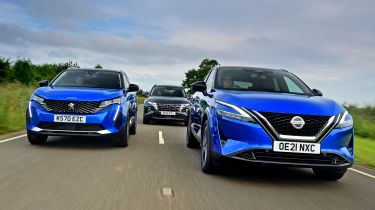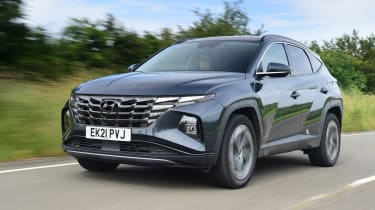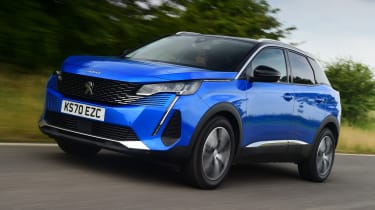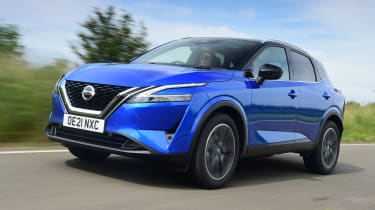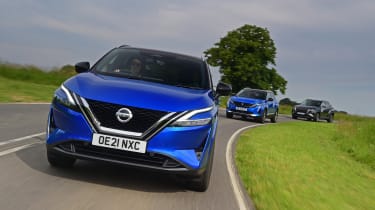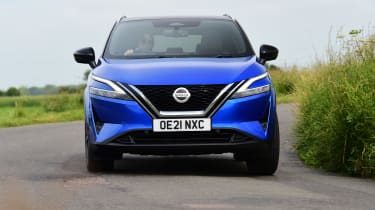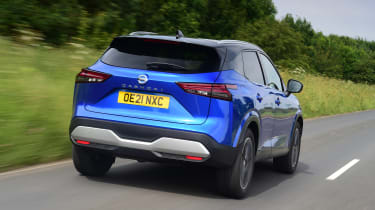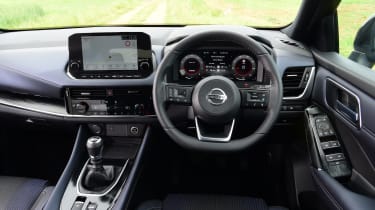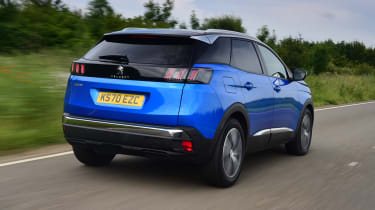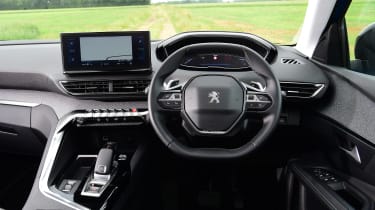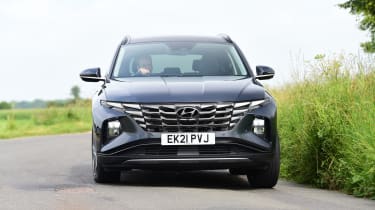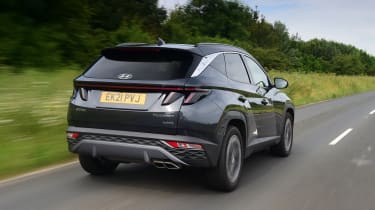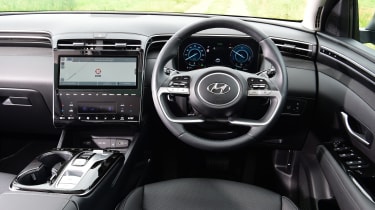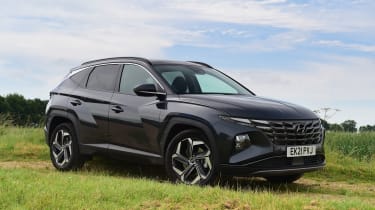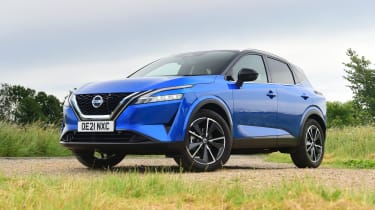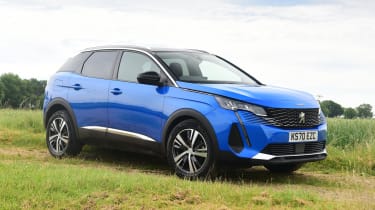Nissan Qashqai vs Peugeot 3008 vs Hyundai Tucson: which used SUV is king of the school run?
The original Nissan Qashqai was a revolution, and it continues to get better, but does it also make a top used family SUV? We test it against the Peugeot 3008 and Hyundai Tucson
The third generation of the Nissan Qashqai didn’t come a moment too soon, because the sporty SUV segment the Japanese brand all but invented with its original model has blossomed ever since with new and improved rivals.
Customers love the SUV concept, and the popular recipe of impressive practicality, fashionable styling and easy driving manners gets an added boost when you factor in the savings of a nearly new or pre-owned model.
The Qashqai is one of our favourite contenders in this sector, but it faces stiff competition from the Hyundai Tucson and Peugeot 3008.
With a few miles under their belts, and representing a big saving on the asking price of a new car, how do these three contenders stack up? They’ve certainly all got plenty of contemporary style and will look great on the school run. So how do these three rivals match up as used-car choices? Read on to compare their finer points.
Hyundai Tucson
- For: Eye-catching styling, spacious accommodation, excellent ride quality, five-year warranty.
- Against: Tucson’s not the most thrilling car to drive, and it’s a little pricier than its two rivals here.
Hyundai may once have been a budget brand, even when compared with relatively mainstream rivals like Nissan and Peugeot, but that’s certainly not the case here today. The stronger residual values we predicted for the Tucson are a reality, and you’ll need to pay a little more for it than for either of its rivals.
Used - available now

2022 Nissan
Qashqai
24,858 milesAutomaticPetrol1.3L
Cash £16,997
2022 Nissan
Qashqai
32,068 milesManualPetrol1.3L
Cash £16,449
2022 Nissan
Qashqai
3,018 milesAutomaticPetrol1.3L
Cash £19,643
2022 Nissan
Qashqai
10,762 milesAutomaticPetrol1.3L
Cash £20,397It’s not enough to sour the deal, though, especially because these are year-old cars with low mileages, and the Hyundai’s price may even be an advantage when you sell it on. The Tucson’s five-year warranty beats its rivals’ three-year deals, too, and means you could sell it on with a year or two’s cover still left.
But all that pragmatic stuff overlooks the fact that the Tucson is by and large the more appealing car. On a practical level, it’s the most spacious, both for passengers and, with its 577-litre boot, for luggage. Its styling has plenty of wow factor inside and out, and the high-quality ride makes it the most enjoyable long-distance cruiser – even if it’s not quite as engaging for keen drivers as the Peugeot. Throw in excellent infotainment systems, plus lots of storage, and the Hyundai Tucson takes the top spot here.
Peugeot 3008
- For: Engaging design and a premium feel to the cabin help make a comfortable cruiser.
- Against: Small 1.2-litre engine is low on grunt, and some drivers find the cockpit layout awkward.
If there’s one aspect of the 3008 some drivers won’t get on with, it’s the unusual siting of the instrument pack, which is designed to be viewed over the top of an oddly squat steering wheel. Or you could decide to enjoy something a little different from the norm, and revel in a fantastic design that looks more like a starship helm than the cabin of a boring old SUV.
Luckily you don’t need to be a space academy graduate to drive a 3008, but the style of its interior alone could well be enough to knock the Qashqai into third place here. However, there’s lot more to the Peugeot besides, notably its ride, which is almost as comfortable as the Tucson’s while offering handling that’s a bit more agile and enjoyable.
The light steering set-up and the smallest turning circle help in urban environments too, and although the small 1.2-litre engine in the entry-level model isn’t the beefiest, it is the most refined and quietest.
Upmarket trim and materials feel a notch above the Qashqai’s – the pre-facelift 3008 took a reassuring second place in our 2020 Driver Power survey – while the 520-litre boot puts it ahead for practicality.
Nissan Qashqai
- For: Chunky styling, and solid performance from a much- improved model.
- Against: Can’t match the flair and premium, sophisticated feel of rivals.
We had high hopes for the third generation of Qashqai, as doubtless did Nissan. But while the car signalled a step change over previous generations, we can’t overlook the fact that the class has moved forward faster. And sadly that’s as true on the used forecourts as it is in the new-car showrooms.
The Qashqai is a decent car, but it can’t match the premium feel of its two rivals here, and they’re both roomier, nicer to drive and just as cheap to run.
The Nissan has one advantage, with prices that are a little lower than the Peugeot’s and Hyundai’s. Yet while that should be a saving grace, it feels more like a reflection of the Nissan’s less appealing offer.
But let’s not be too critical of a car that’s much better to drive than its predecessor, even if it can’t match the smoothness of the Tucson or the deftness of the 3008. And while the Qashqai’s boot is the smallest by some margin at 479 litres, that’s still an impressive amount for a family car, and there are plenty of practical touches like the reversible, wipe-clean boot floor. Nissan has also been lavish with safety kit, which may be a key interest for families.
Which one should you choose?
First place: Hyundai Tucson
Eye-catching style, efficient powertrains and that great warranty help cement the Tucson’s win, in spite of its rivals’ enduring appeal.
Second place: Peugeot 3008
The 3008 comes a close second as a used purchase, thanks to its great design, decent handling, good ride comfort and value.
Third place: Nissan Qashqai
Cheaper pricing isn’t enough to put the Nissan ahead of its rivals, but if you love a keen deal, the car still has plenty to offer.
Did you know you can sell your car with Auto Express? Get the highest bid from our network of over 5,500 dealers and we'll do the rest. Click here to try Auto Express Sell My Car now...
Nissan Qashqai vs Peugeot 3008 vs Hyundai Tucson new car test: July 2021
Below is our original group test of the Nissan Qashqai, Peugeot 3008 and Hyundai Tucson as published in 2021. All information correct at time of publication...
When choosing a family car, what matters most is the sensible stuff: practicality, safety and affordability. It’s function over emotion. However, that’s not to say that those of us in the market for everyday wheels don’t yearn for a little style – and to a large extent, we have Nissan to thank for granting us our wishes.
In the early noughties, Nissan was plodding along with its forgettable Almera hatchback and dull Primera saloon. Neither car was able to trouble the class best, so the Japanese brand decided to take a radical change in direction. Step forward the Qashqai, which mixed a 4x4-inspired body – meaning it was roomy – with running gear that made it nearly as cheap to run as a hatchback. Most crucially, it had a look that meant it was much more desirable, and so the crossover class was born. The Qashqai has flown out of showrooms since, and is regularly among the top-five best-selling cars in the UK.
Maintaining that stronghold is never easy, though, and now there’s a third-generation model to take up the mantle. The 2021 edition is safer, more efficient and more tech-laden than ever before.
We’ve lined it up here against two of its most stylish rivals. The Peugeot 3008 has long been a favourite of ours, and 2021 sees it refreshed with styling tweaks and tech upgrades. Then there’s the new Hyundai Tucson. It’s one of the most distinctive designs on the road, and boasts plenty of substance to back up its head-turning style.
So can the latest Qashqai still deliver the goods? Or will these two alternatives prove that Nissan no longer has things all its own way?
Nissan Qashqai
| Model: | Nissan Qashqai 1.3 DIG-T Xtronic Tekna |
| Price: | £33,465 |
| Engine: | 1.3-litre 4cyl turbo, 154bhp |
| 0-62mph: | 8.9 seconds |
| WLTP economy: | 44.1mpg/9.7mpl |
| CO2: | 145g/km |
| Annual road tax: | £155 |
The Qashqai pictured here is fitted with a six-speed manual gearbox, but we’re comparing it with automatic rivals, so we’re assessing the Qashqai like-for-like. In Tekna trim, it’s priced at £33,465 with the auto, plus another £1,145 for our car’s fetching Magnetic Blue paint with contrasting black roof.
Design & engineering
Nissan clearly approached the third-generation Qashqai with a simple brief: keep the car’s unmistakable looks, yet at the same time deliver a sharper, more modern shape. While the Qashqai Mk3 is instantly familiar, it’s also more substantial – a neat trick to achieve, because the car has grown just 35mm longer and 32mm wider.
Nissan has made moves to improve its construction, though. The latest model features doors and front wings made from aluminium, plus a composite bootlid. Combined with a redesigned structure, the new model, like-for-like, is 60kg lighter than before. The new car uses an updated version of the CMF platform seen under the previous model, and the structure is 48 per cent stiffer than before. The steering has been recalibrated with quicker gearing, while the electric assistance motor has been moved closer to the rack, which is said to reduce friction and give a more natural response.
Most of the range uses a torsion-beam rear suspension layout, but a more advanced multi- link system is available with models equipped with 20-inch alloy wheels or four-wheel drive.
From launch, a 1.3-litre turbocharged petrol engine paired with mild hybrid power comes in two power outputs – 136bhp or 154bhp. A six-speed manual gearbox is available, and so is a CVT automatic. Four-wheel drive is on offer at the top of the range, although this is only expected to account for two per cent of UK sales.
Driving
It's clear that all of the structural and software changes for the Qashqai’s chassis and steering have improved the driving experience dramatically. It feels competent, stable and keen to turn into corners – perhaps too keen. The steering is the most precise here, but it’s also exceptionally light; that’s great for manoeuvring at low speeds around town, but it takes some time to get used to its almost-flighty sensation in normal driving.
The ride feels smooth enough, too. It’s ever so slightly firmer than the Peugeot’s, but the suspension is well controlled without being fidgety. The Hyundai’s is smoother still, though.
Our test car came with the more powerful 154bhp petrol engine. Under hard acceleration the motor becomes rather coarse, and this isn’t helped by the artificial steps inserted into the CVT automatic gearbox. These try to simulate the character of a regular auto, but just feel a little unnatural. Unless you have no choice but to buy the two- pedal set-up, we’d save the hefty £1,900 price increase and get the manual, which is fairly slick.
However, the CVT gearbox does help to overcome the engine’s lack of low-down torque. Before the turbo kicks in at around 1,800rpm, the 1.3-litre turbo feels like it has no power at all. Even with the auto, it really makes you to think twice about pulling out of a junction in a hurry.
Practicality
Nissan’s designers have clearly given a lot of thought to the Qashqai’s practical touches. The rear doors, for example, open to 85 degrees, which means loading bulky child seats is relatively painless. The boot floor is reversible with a wipe-clean surface, which will be very handy when carrying pets or muddy sports gear.
However, when it comes to outright numbers, the Qashqai can’t compete here. Its 479-litre boot is an impressive size – 49 litres bigger than the outgoing car’s – but it’s behind the Peugeot and almost 100 litres less than in the Hyundai. It’s not as usable, either; the 3008’s load lip is closer to the ground, and unlike the other two cars here, the Nissan doesn’t have levers in the boot that fold down the rear seat backs.
It’s a similar story in the cabin. On most fronts the Qashqai is more than adequate, but still behind its competitors. Kneeroom is 20mm up on the old car and is fine in this company, but headroom is the worst here. The need to store our car’s roller blind for the panoramic sunroof does compromise things, but the Hyundai has the same set-up and doesn’t suffer as badly. Storage in the Qashqai is adequate, including a big shelf for a smartphone, but the central cubby between the front seats is much smaller than the (admittedly huge) bins that both the Peugeot and the Hyundai have.
Ownership
Euro NCAP hasn’t yet subjected the latest Qashqai to its safety assessment, but based on the very generous levels of safety-assist tech from the very lowest trim level, a high score is likely. Standard equipment includes forward-collision warning that monitors two cars ahead, lane-keep assist, rear automatic braking and rear cross-traffic alert.
Running costs
Based on official fuel consumption figures, the Nissan’s 44.1mpg sits between the more efficient Peugeot (46mpg) and the thirstier Hyundai (43.5mpg). The 3008 is the only one without mild-hybrid tech, which in theory means that its stop-start system will likely work less, but that proved not to be the case.
Switch on ancillaries such as air-conditioning in the Qashqai, and the engine often idles, because the mild-hybrid battery cannot cope on its own. On the other hand, the Peugeot seems keener to cut its engine. In other words, this is an instance where the term ‘mild hybrid’ should be taken with a pinch of salt.
Testers’ notes: “There’s a lot going on inside the Nissan: piano black and brushed black metallic finishes, plus a trim strip inspired by Japanese wood inlays. It looks fussy.”
Peugeot 3008
| Model: | Peugeot 3008 1.2 PureTech Allure Premium |
| Price: | £31,455 |
| Engine: | 1.2-litre 3cyl turbo, 129bhp |
| 0-62mph: | 9.7 seconds |
| WLTP economy: | 46.0mpg/10.1mpl |
| CO2: | 146g/km |
| Annual road tax: | £155 |
The Peugeot 3008 tested here is the 2021 facelift model. It’s in mid-spec Allure Premium trim which, paired with the turbocharged petrol engine and auto gearbox, comes to £31,455. Optional extras including an electric tailgate (£400), wireless smartphone charging (£120) plus pearlescent paint and a black roof (£725 and £400 respectively) bring the total cost of the car here to £33,000 exactly.
Design & engineering
Throughout the 2000s, Peugeot’s model line-up had very few stand-out performers. That all changed in 2016, however, with the release of the second-generation 3008. It was a huge return to form for the French marque; not only was this a practical family crossover that delivered a ride/handling balance among the best in the class, but it also saw the brand leap right to the head of the mainstream makers when it came to the design and quality of its cars – particularly on the inside.
Five years on, and Peugeot has seen fit to update one of its most well received models. It still rides on the same platform and has the same mechanical layout as before, but benefits from revised styling. Two plug-in hybrid models were added to the range in 2018, although buyers are still able to choose from a 1.5-litre diesel and a 1.2-litre petrol, both with 128bhp. It’s the petrol we’re testing here, mated to an eight-speed automatic gearbox. The diesel is only available with this transmission, while the petrol is also offered with a six-speed manual, which costs £1,600 less than the auto.
One thing that has remained is Peugeot’s i-Cockpit dashboard layout. It helps distinguish Peugeot’s cars from other members of the Stellantis group (Citroen and Vauxhall in particular) by featuring a small steering wheel, which allows the driver to view digital dials above the rim, rather than through the middle, as with most other cars. For some drivers it works well, although depending on your height, you might need to position the wheel lower – or the seat higher – than you’d ideally want to in order to see the instruments clearly.
Driving
While the small steering wheel can feel a little odd to hold, it makes the 3008 feel very light and easy to manoeuvre at low speeds. There’s more to the Peugeot than that, though; at 10.7 metres, the car’s turning circle is tighter than either the Nissan’s (11.5 metres) or the Hyundai’s (11.8 metres).
By class standards, the 3008 is among the more comfortable options to drive, even if the Tucson edges it for ride quality. Unlike the Hyundai, however, the 3008 is also above average when it comes to handling. Admittedly it’s still not the sort of car to put a big grin upon your face, but it feels reasonably agile for a family SUV.
While the 1.2-litre turbo doesn’t quite feel as muscular as the Nissan’s 1.3-litre turbo or the Hyundai’s 1.6, and despite the fact that it’s one cylinder short of both of its rivals, it’s the quietest and most refined unit here. The eight-speed gearbox is very smooth at speed, too, although the 3008 can be incredibly frustrating to drive in slow-moving traffic. The stop-start system is the issue here; it engages too soon when coming a halt and jams the brakes on in the process. Ease off the pedal to make the car perform a more
gentle halt, and the engine has a tendency to fire up. It takes the shine off what would otherwise be a really slick powertrain.
Practicality
With a liberal use of fabrics in place of plastics, the Peugeot’s cabin looks and feels expensive beside the Nissan. But it’s not just about the looks – it’s well thought out, too. Isofix points are standard on the two outer rear seats and the front passenger seat, too. When it’s unoccupied, the backrest can fold forward. It means that, with the rear row also folded, the Peugeot is able to carry much longer items than either the Qashqai or the Tucson.
Lift that front seat back up again, and the Peugeot’s carrying capacity measures 1,482 litres, placing it second behind the Tucson. The same goes for the 520-litre boot when all the seats are in place; it’s comfortably more than the Nissan’s 479 litres, but lags behind the Hyundai’s 577 litres. In reality, however, it’s still impressively spacious.
Rear-seat passengers will agree. Kneeroom is similar to the Nissan’s, while headroom is an inch or two better. The 3008 is the best for a third occupant in the middle seat – thanks to both the smallest central hump in the floor (giving everyone more foot space), and the softest backrest of this trio.
Despite the swoopy dashboard, the 3008 impresses for storage on the whole. The front door pockets can each hold a big bottle, but the car’s glovebox is tiny.
Ownership
The impression of strong perceived quality in the 3008 has been confirmed by owners. In our 2020 Driver Power satisfaction survey the 3008 was voted the second best car to own in the UK, beaten only by the Kia Sorento (see p61). With only subtle changes for the 2021 update, it’s likely that the 3008 will continue to rate strongly.
The good news continued for Peugeot elsewhere. There was an eighth-place finish for Peugeot overall – beating both Nissan (11th) and Hyundai (13th) in the process. Its dealers fared even better, bagging a fifth-place ranking; that’s 11 spots higher than Hyundai’s and 15 above Nissan’s.
Running costs
There's only one gramme per kilometre separating each of these cars on CO2 emissions, so the differences in company car tax rates are negligible. In Allure Premium trim, the 3008 is the cheapest car on test, which means a lower-rate income tax payer will face deductions of £2,058, compared with £2,130 for the Hyundai and £2,169 for the Nissan.
Testers’ notes: “Five years on, and those ‘piano key’ switches on the 3008’s dash still look great. It’s just one of the reasons why the car feels unique and expensive.”
Hyundai Tucson
| Model: | Hyundai Tucson 1.6 T-GDi MHEV DCT Premium |
| Price: | £32,540 |
| Engine: | 1.6-litre 4cyl turbo, 148bhp |
| 0-62mph: | 9.6 seconds |
| WLTP economy: | 43.5mpg/9.6mpl |
| CO2: | 146g/km |
| Annual road tax: | £155 |
While the Hyundai Tucson pictured here is in top-spec Ultimate trim and paired with a full hybrid powertrain, the closest competition to the Qashqai and 3008 is the lower Premium model with a mild-hybrid petrol engine. At £32,540, it splits the Peugeot and Nissan on price.
Design & engineering
The Tucson has long been a well established offering in the family crossover class, chalking up worldwide sales of more than seven million units since it was launched in 2004. Despite this, the previous three generations never quite established themselves as the stand-out choice in the class. Little more than a quick glance at the latest version shows that Hyundai is showing much greater ambition with this Mk4 edition.
The styling is quite unlike any other previous car from the Korean brand, or indeed anything else in the segment. From the dramatic grille, which neatly integrates the front LED lighting, to the distinctive creases and surfaces along the sides, it’s undoubtedly one of the most eye-catching SUVs around.
While the cabin might not have the Peugeot’s initial wow factor, it’s a very pleasant place to sit. The sweeping upper part of the dash, seamlessly blending into the air vents, is very elegant, and the conventionally sized steering wheel frames a razor-sharp 10.25-inch digital driver’s display. It feels exceptionally sturdy, and small details like the knurled finish to the wiper and indicator stalks just give off further subtle hints of quality.
Hybrid powertrains play a big role in the Tucson’s engine line-up. The range is topped by a plug-in model, which pairs a 1.6-litre petrol engine with an electric motor and a 13.8kWh battery; the result is 261bhp and an electric-only range of 31 miles.
Below that sits a conventional hybrid (the car shown in our images), which offers 227bhp and the promise of 49.6mpg. The 1.6-litre turbocharged mild-hybrid petrol we’re testing (a non-mild-hybrid is also available at the entry point of the range) offers 148bhp and 250Nm of torque. A six-speed manual transmission is available, while auto buyers can have a seven-speed dual-clutch unit for an extra £1,215.
Driving
There's one minus point to the way the Tucson drives: it’s not particularly fun. It feels weighty compared with these test rivals (it’s 160kg heavier than the Peugeot), so it’s not going to be the first choice for the keen driver.
However, in the same way that criticising a supercar for a small boot would be pointless, a similar principle applies here. What matters far more than keen handling is that the Tucson feels safe, stable and – more than anything else – very relaxing. Its ride comfort is the best here, as is the Hyundai’s ability to isolate road noise from the cabin. As a result, it’s a superb long-distance cruiser.
The extra weight makes a difference in a straight line too. Even though the Hyundai’s 1.6-litre engine has 19bhp more than the Peugeot’s 1.2, there’s just 0.1 seconds in the 0-62mph times (9.6 seconds for the Tucson, 9.7 seconds for the 3008).
Still, performance is adequate, and the dual-clutch gearbox is the best here. It’s also smoother than the Peugeot’s torque convertor auto (especially at low speeds) and less droney than the Nissan’s CVT. It’s just a shame that under hard acceleration the engine sounds rough. Despite this, the Tucson is still the best package overall from behind the wheel.
Practicality
Considering that the Tucson is only marginally the largest car here – it’s 75mm longer than the Qashqai and 10mm lower – it’s comfortably the most spacious inside. Headroom in particular is great – despite the panoramic sunroof, it’s still the Peugeot’s equal – but legroom is marginally better than the competition, too. The centre seat is superior to the Nissan’s, but not quite as comfortable as the Peugeot’s.
The Tucson also has the biggest boot. The 577-litre volume is right up with the best in the class, and comfortably ahead of its rivals here. Should you need to store taller items, then the parcel shelf can be stored out of the way beneath the boot floor. Each of these cars is available with a 12-volt socket in the back for powering auxiliary items. Fold the Hyundai’s rear seats down, and the vast 1,756-litre volume is comfortably the largest.
Moving back into the front of the cabin, and the Tucson’s generous door bins, central storage cubby and big glovebox mean that it tops the group when it comes to carrying odds and ends.
Ownership
like the Qashqai, the Tucson has yet to be subjected to Euro NCAP’s crash tests. However, we believe it will achieve a very strong safety rating. Among the seven airbags fitted is a central side system between the front seat occupants, plus curtain airbags to protect everyone from side impacts.
In top trim levels, there’s a side-view monitor; when the indicators are activated, images from side-mounted cameras are relayed in the digital dials to provide a real-time view of any potential hazards in the driver’s blind spots. Forward collision warning with pedestrian detection is also standard.
Running costs
Factor in the costs of residual values, and the Hyundai holds an advantage over the competition. After three years and 36,000 miles, the 3008 will retain 48 per cent of its value, but the Tucson will still be worth nearly 54 per cent of its original price. The Qashqai splits the two, and this particular variant will be worth 49.75 per cent of its £33,465 asking price after the same time period.
All three cars have a fuel tank between 53 and 55 litres. In the real world, this should give each a range of roughly 450 miles with a gentle right foot.
Testers’ notes
“Other than SE Connect models, all Tucsons feature interior ambient lighting, which adds a subtle glow to areas like the door pockets and smartphone cubby.”
Verdict
First place: Hyundai Tucson
Thanks to its fantastic interior tech, brilliant practicality and class-leading comfort, the Tucson takes the overall win. Only the Peugeot comes close to competing with its interior design and quality in this class, while strong residual values translate into competitive monthly finance payments – making top-spec models significantly better value for money. Only a slightly rough engine lets it down; it’s otherwise close to faultless.
Second place: Nissan Qashqai
While the new Qashqai is accomplished, the family SUV class has moved on. Competitive monthly payments save it from last place here, but these rivals are more spacious, more refined and as cheap to run, yet both feel like a step up in terms of design and quality. The auto gearbox is worth avoiding, too. The Qashqai is far from a bad car – and it’s a big improvement over its predecessor – but it’s no class leader.
Third place: Peugeot 3008
The 3008 brings up the rear, and unfortunately that’s down to its price – especially on monthly finance payments. If you’re willing to stretch the budget a little (or drive a hard bargain at a Peugeot dealer), it gets the nod over the Nissan – but not the Tucson. It’s a more desirable package than the Qashqai; inside it feels more expensive and is also more spacious. While it’s a little slower, it’s better to drive, too.
Figures
| Hyundai Tucson 1.6 T-GDi MHEV DCT Premium | Nissan Qashqai 1.3 DIG-T Xtronic Tekna | Peugeot 3008 1.2 PureTech auto Allure Premium | |
| On the road price/total as tested | £32,540 | £33,465/£34,610 | £31,455/£33,000 |
| Residual value (after 3yrs/36,000) | £17,549/53.93% | £16,649/49.75% | £15,124/48.08% |
| Depreciation | £14,991 | £16,816 | £16,331 |
| Annual tax liability std/higher rate | £2,130/£4,260 | £2,169/£4,338 | £2,058/£4,116 |
| Annual fuel cost (12k/20k miles) | £1,655/£2,759 | £1,633/£2,721 | £1,565/£2,609 |
| Insurance group/quote/VED | 15/£334/£155 | 15/£382/£155 | 21/£378/£155 |
| Cost of 1st/2nd/3rd service | £99/£169/£229 | £640 (3 years) | £651 (3 years) |
| Length/wheelbase | 4,500/2,680mm | 4,425/2,665mm | 4,447/2,675mm |
| Height/width | 1,615/1,865mm | 1,625/1,835mm | 1,624/1,841mm |
| Engine | 4cyl in-line/1,598cc | 4cyl in-line/1,332cc | 3cyl in-line/1,199cc |
| Peak power/revs | 148/5,500 bhp/rpm | 154/5,500 bhp/rpm | 129/5,500 bhp/rpm |
| Peak torque/revs | 250/1,500 Nm/rpm | 270/1,800 Nm/rpm | 230/1,750 Nm/rpm |
| Transmission | 7-speed auto/fwd | CVT auto/fwd | 8-speed auto/fwd |
| Fuel tank capacity/spare wheel | 54 litres/repair kit | 55 litres/repair kit | 53 litres/repair kit |
| Boot capacity (seats up/down) | 577/1,756 litres | 479/1,422 litres | 520/1,482 litres |
| Kerbweight/payload/towing weight | 1,491/609/1,650kg | 1,385/425/1,400kg | 1,320/620/1,400kg |
| Turning circle | 11.8 metres | 11.5 metres | 10.6 metres |
| Basic warranty (miles)/recovery | 5yrs (unlimited)/5yrs | 3yrs (60,000)/3yrs | 3yrs (60,000)/1yr |
| Driver Power manufacturer/dealer pos. | 13th/16th | 11th/20th | 8th/5th |
| NCAP: Adult/child/ped./assist/stars | N/A | N/A | 85/85/67/58/5* |
| 0-62mph/top speed | 9.6 secs/117mph | 8.9 secs/124mph | 9.7 secs/117mph |
| WLTP economy/range | 43.5mpg/517 miles | 44.1mpg/534 miles | 46.0mpg/536 miles |
| WLTP combined | 9.6mpl | 9.7mpl | 10.1mpl |
| Claimed CO2/tax bracket | 146g/km/33% | 145g/km/33% | 146g/km/33% |
| Airbags/Isofix/park sensors/camera | Seven/yes/F&R/yes | Six/yes/F&R/yes | Six/yes/F&R/yes |
| Auto box/lane keep/blindspot/AEB | Yes/yes/yes/yes | Yes/yes/yes/yes | Yes/yes/yes/yes |
| Climate/cruise control | Yes/adaptive | Yes/adaptive | Yes/yes |
| Leather/heated seats | No/yes | No/yes | £1,300/£1,300** |
| Metallic paint/LED headlights | £665/yes | £565/yes | £575/yes |
| Keyless entry/power tailgate | Yes/no | Yes/yes | Yes/£400 |
| Sat-nav/digital dashboard | Yes/yes | Yes/yes | Yes/yes |
| DAB radio/connected services | Yes/yes | Yes/yes | Yes/yes |
| Wireless charge/CarPlay/Android Auto | Yes/yes/yes | Yes/yes/yes | £120/yes/yes |
